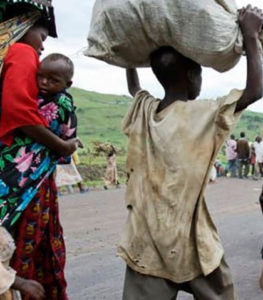The forgotten refugees – IDPs
They are the refugees that the world has forgotten – the 40 million people who are Internally Displaced Persons (IDPs).
IDPs are people forced to flee their home and seek refuge elsewhere inside their home countries and they often struggle for the same recognition, protection and support afforded exiled refugees.
Twenty years ago the UN launched a set of guiding principles on internal displacement which built on existing agreements such as the Geneva Conventions, the 1951 Refugee Convention, and the Universal Declaration of Human Rights – committed to by all of the ratifying governments.
These principles aimed to identify the rights and guarantees relevant to the protection of the internally displaced in all phases of displacement. They were meant to provide protection against arbitrary displacement, offer a basis for protection and assistance during displacement, and set forth guarantees for safe return, resettlement and reintegration.
But two decades on governments across the globe are failing to implement them.
Chair of ALNAP, a global network for learning and improvement of the humanitarian system, Professor Johan Schaar says that while violations of international law can be prosecuted in the International Criminal Court, the International Court of Justice and other tribunals; when IDPs can’t enjoy basic rights found in domestic law – for example to education, health services, or to vote – “it speaks to deep problems of neglect that can’t be prosecuted by international bodies”.
“The lack of application of the guiding principles since 1998 reveals not only a lack of awareness of the needs of IDPs, but also of the inability of states to prevent and resolve the crises that force people to flee within their own country,” Professor Schaar said.
When the principles were created, there were about 20 million IDPs; by last year that number had doubled – an increase driven by enduring conflicts and a rising number of extreme weather events.
Increasingly, those who flee from armed conflicts often remain IDPs for many years.
Prof Schaar says the economic fallout from internal displacement needs to be addressed.
“Firstly, in terms of shelter, healthcare, and food, these can be estimated with relative ease, but the more intangible societal burden – lost opportunities in education, investments and revenue, psychological trauma, and social fragmentation – is harder to pin down,” he said.
He said the Internal Displacement Monitoring Centre (IDMC) in Geneva had begun a new program to estimate these costs, so that the real burden to societies becomes known and can be factored into national plans and budgets.
“Second, access to data on existing levels and new flows of internal displacement must be improved. IDMC uses a broad range of formal and informal sources for its statistics – sources often afflicted with considerable uncertainty as states don’t always register the correct information or make data public,” Prof Schaar said.
Finally, and most importantly, governments in the affected countries must be encouraged and supported to take more responsibility for their IDPs, Prof Schaar said.
“Much has happened in terms of protection and assistance during displacement, but a great deal remains to be done to prevent flight in the first place, and to enable safe return and reintegration,” he said.
“Many states are not taking these responsibilities as seriously as their citizens have the right to expect. And some are committing, or allowing, grave violations of international humanitarian law and human rights.
“Displacement has, in some countries, been enforced, or even prevented, through siege. And several fragile and conflict-prone states lack the capacity to even implement the principles,” Prof Schaar said.
The UN reports that in Somalia, IDPs find their way to cities when violence, drought, and floods undermine their rural livelihoods.
The largest increase in 10 years occurred in 2017 – there are now 600,000 IDPs in Mogadishu. In the absence of legislation and regulations, they live under great insecurity, especially in the capital
In Ethiopia, the UN reports, the new government has created political openings and the beginning of reconciliation with Eritrea. But communal tensions over access to natural resources in 2018 led to violence between ethnic groups in the south of the country that created the largest number of new IDPs anywhere in the world.
Hundreds of thousands of these people were being assisted with relative efficiency by the authorities but were forced to return towards the end of the year under the threat of having assistance taken away – even though the conflict in the south remained unresolved.
In Syria, a degree of stability is emerging as the regime regains control of large parts of the country. But 2.9 million new IDPs were created in 2017 – many finding themselves in the Idlib province, which remains under threat from a new military offensive.
Syrian IDPs are often hard to reach for humanitarian actors struggling to gain access to areas both under and outside of government control.
Prof Schaar says the number of people forced to flee violence and the impacts of climate change is growing.
“The Guiding Principles on Internal Displacement should be increasing their chances of receiving protection and assistance. But they need to be respected and, without the political will to prevent people from being forced to leave their own homes in the first place, they are insufficient,” he said.
Laurie Nowell
AMES Australia Senior Journalist












